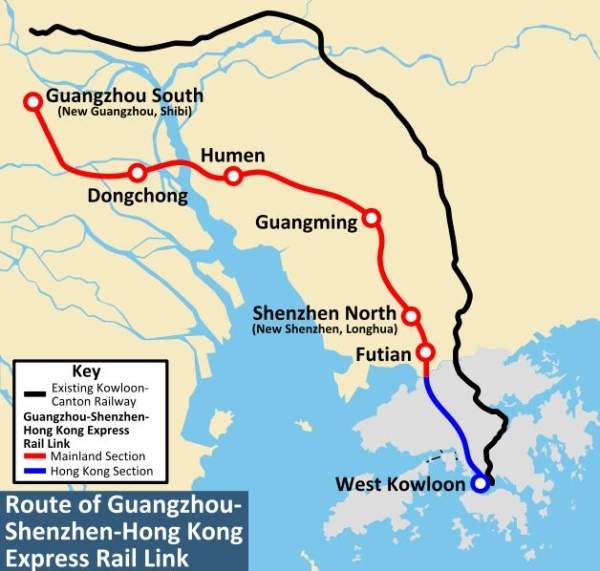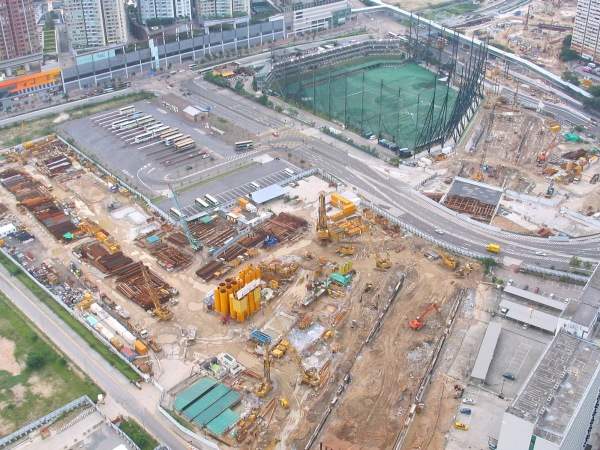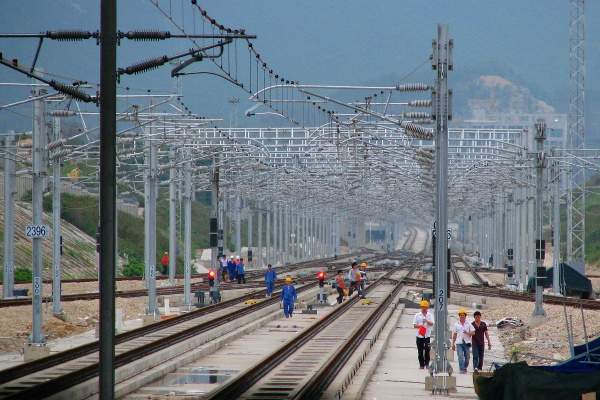The 26km Hong Kong section of Guangzhou-Shenzhen-Hong Kong express rail link (XRL) will connect Hong Kong with Shenzhen and Guangzhou.
The project is aimed at reducing the travel time between Hong Kong and Guangzhou. The total length of the Guangzhou-Shenzhen-Hong Kong Express rail link will be 142km, which will be completed in two sections – the Guangzhou section (116km) and the Hong Kong (26km).
The construction began in January 2011 and is expected to be completed by May 2015. MTR Corporation is the operator of the project.
The corridor is expected to carry about 99,000 passengers a day by 2016. The estimated journey time after the construction of corridor will reduce to 14 minutes between Hong Kong and Futian stations, 23 minutes between Hong Kong and Shenzhen North and 48 minutes between Hong Kong and Guangzhou South.
Guangzhou-Shenzhen-Hong Kong express rail link project details
The Hong Kong Special Administrative Region (HKSAR) Government proposed the Hong Kong section of the express rail link in 2000. The Legislative Council of Hong Kong discussed on the proposal between 2005 and 2007. The Chief Executive Council adopted a dedicated corridor option in August 2007.
In April 2008 MTR Corporation was asked to carry out planning and design on the proposed express rail link. In October 2009, amendments were made to the proposed express link.
Funding for construction of the corridor project was approved by the Legislative Council in January 2010. Construction of the corridor commenced in January 2010.
The line also runs from West Kowloon in Hong Kong to Huanggang and will be connected with the 16,000km national high-speed railway network. It will have one station at West Kowloon in Hong Kong.
Line routes on the Guangzhou-Shenzhen-Hong Kong XRL
The Guangzhou-Shenzhen-Hong Kong express rail link will begin at Guangzhou South and run through Dong Chong, Humen, Guangming, Shenzhen North and Futian to end the mainland link. It will then continue to West Kowloon as the Hong Kong section.
Infrastructure and construction of the major Chinese line
The design of the express line was aimed at minimising the impact on the nearby communities. The construction began by the end of January 2010 and is expected to be completed by 2015.
It includes construction of 26km of dedicated underground track, emergency rescue sidings and the stabling sidings in Shek Kong, ventilation facilities at Mai Po, Ngau Tam Mei and Pat Heung, along with an emergency access point at Tai Kong Po.
It also includes construction of a temporary magazine site near Tai Shue Ha in Yuen Long for the blasting operations during construction.
Tunnel boring machines will be used for the construction of tunnels along the line. Construction of tunnels at Tse Uk Tsuen in Pat Heung and Shek Yam in Kwai Chung will be carried out by using drill and blast method.
The cut and cover method will be used for the construction of emergency rescue sidings and stabling sidings at Shek Kong.
Contractors playing a role in the project
Bachy Soletanche Group was awarded a HK$461m ($59.30m) contract to construct the West Kowloon terminus and diaphragm walls. Hsin Chong Construction was awarded a HK$333.8m ($42.92m) contract for removal and reprovisioning of the Nam Cheong property foundation.
The Tysan Foundation and VIBRO-Chun Wo joint venture were awarded HK$497m ($63.94m) and HK$321.2m ($41.3m) contracts for carrying out works on West Kowloon terminus piles north and south sites respectively.
Removal of obstructions on the Sham Mong road will be carried out by Paul Y. Construction under a HK$159m ($20.55m) contract.
The joint venture of Laing O’Rourke-Hsin Chong-Paul Y will construct a south of West Kowloon terminus station under a HK$3.3bn ($426.9m) contract. Bachy Soletanche and Laing O’Rourke joint venture were awarded a HK$1.03bn ($133.6m) contract to construct the north of West Kowloon terminus station.
Gammon and Leighton joint venture was awarded with a HK$2.9bn ($370.7m) contract to build an approach tunnel at West Kowloon terminus south. The construction of the north approach tunnel for West Kowloon terminus was assigned to the Bachy Soletanche and Laing O’Rourke joint venture for HK$1.03bn ($133.68m).
The joint venture of Dragages and Bouygues were awarded HK$3.6bn ($471.7m) and HK$1.38bn ($177.9m) contracts for constructing tunnels from Mei Lai road to Hoi Ting road and Shek Yam to Mei Lai road respectively.
Leighton Contractors (Asia) were awarded a HK$3.2bn ($415.97m) contract to construct tunnels from Tse Uk Tsuen to Shek Yam.
The joint venture of Maeda and China State was awarded with a HK$1.5bn ($193.1m) contract to build tunnels from Tai Kong Po to Tse Uk Tsuen. It was also awarded a HK$3.2bn ($413.7m) contract which involves construction of Shek Kong stabling sidings and emergency rescue sidings.
ATAL Engineering was awarded two contracts worth HK$297.3m ($38.23m) and HK$140m ($18.05m) respectively to provide services for tunnel ventilation facilities and emergency rescue sidings as well as Shek Kong stabling sidings.
Penta-Ocean Construction will build tunnels from Mai Po to Ngau Tam Mei under a HK$1.6bn ($216.46m) contract. Construction of tunnels from Huanggang to Mai Po was assigned to the CRCC-HC-CR15G joint venture for HK$1.69bn ($217.4m).
On 6th July 2011, the Chun Wo – CRGL – QR joint venture was assigned with a HK$1.16bn ($150.2m) contract for the track work and overhead line systems. In May 2011, the GAS joint venture was awarded with a contract worth HK$259m ($33.41m) to provide tunnel environmental control systems.
In August 2011, the Shinryo Corporation was awarded with a HK$294m ($37.3m) contract to provide trackside auxiliaries. In August 2011, the Kier-Kaden-OSSA joint venture was awarded with a HK$1.5bn ($194.7m) contract to build tunnels from Ngau Tam Mei to Tai Kong Po.










